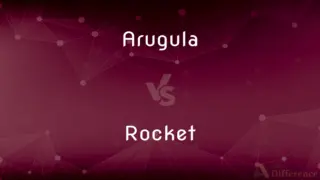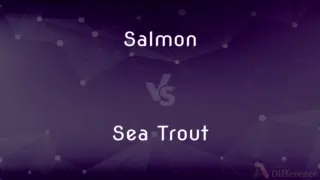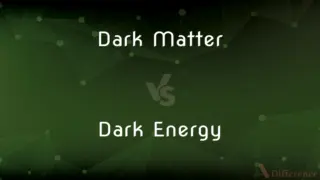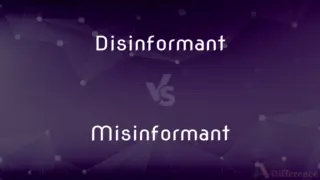Vinasse vs. Molasses — What's the Difference?
By Tayyaba Rehman & Urooj Arif — Updated on April 4, 2024
Vinasse is a byproduct of the distillation process used in biofuel and fertilizer production, while molasses is a thick syrup byproduct from sugar refining, used in food, animal feed, and ethanol.

Difference Between Vinasse and Molasses
Table of Contents
ADVERTISEMENT
Key Differences
Vinasse and molasses originate from different stages in the processing of sugarcane and sugar beets. Vinasse is produced during the distillation of fermented sugarcane or beet juice, primarily in the production of bioethanol and alcoholic beverages like rum. It's a liquid waste with high organic content, making it suitable as a biofertilizer or for biogas production. Molasses, on the other hand, is a thick, dark syrup left over after the crystallization of sugar from cane or beet juice. It contains sugars that weren't crystallized, along with minerals and other substances, and finds uses in food production, as livestock feed, and as a fermentation substrate in ethanol and rum production.
Vinasse's primary use is agricultural; it's valued for its high potassium content and ability to improve soil health when used as a biofertilizer. This application leverages the nutrient-rich nature of vinasse to support plant growth and soil conditioning. Molasses serves a broader range of purposes due to its sugar content and flavor profile. It's used in the culinary world to sweeten and flavor foods, in the production of animal feed to improve palatability and nutritional value, and in fermentation processes, where its sugars are converted into ethanol or used in baking and brewing.
The composition of vinasse can vary significantly depending on the feedstock (sugarcane, beet, or grains) and the specifics of the distillation process. Generally, it's rich in organic matter and minerals but low in sugar content. Molasses, however, consistently has a high sugar content, along with vitamins and minerals, making it nutritionally valuable. This contrast highlights their suitability for different applications: vinasse for soil enhancement and biogas production, and molasses for food, feed, and industrial fermentation uses.
Vinasse is often treated as a waste product in distilleries, with management practices focused on environmental protection due to its potential to pollute water sources. Its utilization in agriculture or bioenergy production is part of waste valorization efforts. Molasses, being a valuable byproduct of sugar production, is traded internationally and used in a variety of industries, from food and beverage to biofuels, showcasing its versatility and economic value.
While both vinasse and molasses are byproducts of sugar-related industries, their economic impacts differ. Vinasse's value is primarily in agricultural and environmental applications, enhancing sustainability and waste utilization. Molasses contributes more directly to the economy through its role in food, beverage, and biofuel production, alongside international trade. This distinction underscores the broader utility and commercial significance of molasses compared to the more niche, though environmentally beneficial, applications of vinasse.
ADVERTISEMENT
Comparison Chart
Origin
Byproduct of distillation (ethanol, rum).
Byproduct of sugar crystallization.
Primary Use
Biofertilizer, biogas production.
Food sweetener, animal feed, ethanol.
Composition
High in organic matter, low in sugar.
High in sugar, vitamins, minerals.
Application
Agriculture, environmental management.
Food industry, livestock, biofuel.
Economic Impact
Waste valorization, soil health improvement.
Direct commercial use, international trade.
Compare with Definitions
Vinasse
Primarily used in agriculture for soil enhancement.
Vinasse is utilized in biogas production due to its high organic content.
Molasses
A thick syrup byproduct from sugar refining, rich in sugars and minerals.
Molasses is often used in baking for its rich flavor and color.
Vinasse
Treated as waste, with environmental management considerations.
Proper disposal and use of vinasse are important to prevent water pollution.
Molasses
Contains sugars, vitamins, and minerals.
The nutritional value of molasses makes it a popular feed additive for livestock.
Vinasse
A byproduct of the distillation process, rich in organic content.
Vinasse is applied to agricultural fields as an organic biofertilizer.
Molasses
Plays a significant role in the food and beverage industry and in international trade.
The versatility of molasses contributes to its demand in various industries.
Vinasse
High in potassium and organic matter.
The nutrient-rich composition of vinasse makes it an excellent soil amendment.
Molasses
Used in food, animal feed, and ethanol production.
Molasses serves as a substrate in fermentation processes for ethanol and rum.
Vinasse
Valued for enhancing sustainability and waste utilization in agriculture.
Farmers value vinasse for its ability to improve soil health economically.
Molasses
Treated as a valuable byproduct in sugar industries.
Blackstrap molasses, the final byproduct, is particularly rich in minerals.
Vinasse
Vinasse is a byproduct of the sugar or ethanol industry. Sugarcane or sugar beet is processed to produce crystalline sugar, pulp and molasses.
Molasses
Molasses () or black treacle (British English) is a viscous substance resulting from refining sugarcane or sugar beets into sugar. Molasses varies by the amount of sugar, method of extraction, and age of plant.
Vinasse
The residue left in a still after the process of distillation.
Molasses
A thick syrup produced in refining raw sugar and ranging from light to dark brown in color.
Vinasse
(chemistry) The waste liquor remaining in the process of making beet sugar, used in the manufacture of potassium carbonate.
Molasses
Any of various thick syrups made from juice extracted from the fruits or stalks of certain plants
Pomegranate molasses.
Vinasse
The waste liquor remaining in the process of making beet sugar, - used in the manufacture of potassium carbonate.
Molasses
A thick, sweet syrup drained from sugarcane, especially (North America) the still thicker and sweeter syrup produced by boiling down raw molasses.
Molasses
(US) Any similarly thick and sweet syrup produced by boiling down fruit juices, tree saps, etc., especially concentrated maple syrup.
Molasses
(figurative) Anything considered figuratively sweet, especially sweet words.
He really poured on the molasses, charming his audience and changing more than a few votes.
Molasses
Plural of molass: whiskey made from molasses.
Molasses
Synonym of molass: whiskey made from molasses.
Molasses
(geology) molasse
Molasses
(obsolete) molass: becomes drunk from molass.
Molasses
The thick, brown or dark colored, viscid, uncrystallizable sirup which drains from sugar, in the process of manufacture; any thick, viscid, sweet sirup made from vegetable juice or sap, as of the sorghum or maple. See Treacle.
Molasses
Thick dark syrup produced by boiling down juice from sugar cane; especially during sugar refining
Common Curiosities
Can vinasse be used in food production?
Typically, vinasse is not used in food production due to its low sugar content and is instead used in agriculture and environmental management.
What is vinasse?
Vinasse is a liquid byproduct from the distillation of fermented sugarcane or beet juice, used as a biofertilizer and in biogas production.
What agricultural benefits does vinasse offer?
It improves soil health by adding organic matter and nutrients, promoting plant growth.
What makes molasses valuable in animal feed?
Its high sugar content and nutritional value enhance the palatability and nutritional quality of animal feed.
How is molasses used in ethanol production?
The sugars in molasses can be fermented to produce ethanol, used in fuel and alcoholic beverages.
Are there environmental concerns associated with vinasse?
Yes, improper disposal of vinasse can lead to water pollution, so its management is crucial for environmental protection.
Why is molasses popular in baking?
Its rich flavor and color enhance baked goods, and it acts as a natural sweetener.
What is molasses?
Molasses is a thick syrup byproduct from sugar refining, used in food, animal feed, and as a substrate in ethanol and rum production.
How do vinasse and molasses differ in composition?
Vinasse is high in organic matter and minerals but low in sugars, whereas molasses is rich in sugars, vitamins, and minerals.
Is vinasse traded internationally like molasses?
Vinasse is less commonly traded internationally due to its specific use in agriculture and environmental management, unlike molasses, which has broader commercial applications.
Share Your Discovery

Previous Comparison
Capris vs. Culottes
Next Comparison
Carjacking vs. CarnappingAuthor Spotlight
Written by
Tayyaba RehmanTayyaba Rehman is a distinguished writer, currently serving as a primary contributor to askdifference.com. As a researcher in semantics and etymology, Tayyaba's passion for the complexity of languages and their distinctions has found a perfect home on the platform. Tayyaba delves into the intricacies of language, distinguishing between commonly confused words and phrases, thereby providing clarity for readers worldwide.
Co-written by
Urooj ArifUrooj is a skilled content writer at Ask Difference, known for her exceptional ability to simplify complex topics into engaging and informative content. With a passion for research and a flair for clear, concise writing, she consistently delivers articles that resonate with our diverse audience.















































